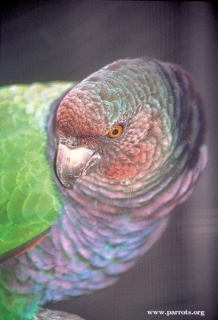Imperial Amazon |
|
|
Also known as: Sisserou, August Amazon (Parrot), Dominican Amazon (Parrot)
Did You Know?
The Imperial Amazon is the largest of the Amazons at 45cm (17.5 in), 900g (31.5 oz).Programs & Projects
WPT has worked with numerous partners to help save this species. Learn moreAcademic Research
Related publications: Amazona imperialisSpecies Profile
Genus: Amazona | Species: imperialis
Size:
48 cm (18.7 in)
Weight:
900g (31.5 oz) - males 650g (22.75 oz) - females
Subspecies including nominate:
one
Colour Adult:
Both adults brown/purple forehead and lores, becoming browner on cheeks to ear coverts; burgundy/maroon crown and neck, washed with green/blue, the feathers edged with black; breast and abdomen dark lilac/purple, the feathers edged dusty black; olive/green lower underparts, feathers tipped green/blue; upperparts dark green, feathers edged black; secondary feathers 1-3 dark burgundy at bases, the remaining secondaries green; red carpal edge; tail red/brown. Bill grey/horn. Eye-ring grey/brown, eye orange/red.
Colour Juvenile:
As in adult but duller; face dull red/brown; occiput to hindneck green; area behind cheeks tinged with green. Eye brown.
Call:
Wide variety of calls including whistles, shrieks and squawks. Often loud, but also can be squeaky.
Listen NowMore Information:
Avibase
First observations of the impacts of Hurricane Maria on the endemic Imperial Amazon
Rare Species Conservatory Foundation
Content Sources:
CITES
BirdLife International
Cornell Lab of Ornithology/Birds of the World
A Guide to Parrots of the World, Juniper and Parr, 1998
ML Media Collection Catalogue 37824, Imperial Parrot Amazona imperialis, Robbins, Mark, Dominica, Apr. 9 1987, Cornell Lab of Ornithology. Site
Parrots of the World, Forshaw and Cooper, 1989. 2010 edition
Parrots of the World, Forshaw, 2006.
Did You Know?
The Imperial Amazon is the largest of the Amazons at 45cm (17.5 in), 900g (31.5 oz).Programs & Projects
WPT has worked with numerous partners to help save this species. Learn moreAcademic Research
Related publications: Amazona imperialisSpecies Care
Captive Status:
Extremely rare
Longevity:
50-60 yrs
Housing:
Outside flight if possible - 10 x 3 x 2.5m (32.8 x 9.8 x 8.2 ft); inside enclosure 3 x 3 x 2.5m (9.8 x 9.8 x 8.2 ft). Metal construction necessary.
Diet:
Not recorded but assumed to be mainly the same as other Amazon parrots with care not to feed high fat diet: fruit such as: apple, pear, orange, cactus fruit, pomegranate, forming about 30 % of diet; vegetables such as: carrot, celery, green peas and beans; green leaves such as: Swiss chard, kale, dandelion, chickweed; fresh corn; spray millet, small seed mixture (lower fat, limited sunflower); peanuts occasionally; complete kibble.
Enrichment:
Provide lots of chew and forage items - bird safe wood such as fir, pine, elder or willow, wood block toys vegetable tanned leather toys, heat sterilized pine cones; also enjoys bathing so provide overhead misters or shallow water bowls.
Nest Box Size:
Nest box 14" x 14" x 48" (35.5cm x 35.5cm x 122cm).
Clutch Size:
2
Incubation Time:
About 28 days.
Fledging Age:
Not recorded.
Hatch Weight:
Not recorded.
Peak Weight:
Not recorded.
Weaning Weight:
Not recorded.
Did You Know?
The Imperial Amazon is the largest of the Amazons at 45cm (17.5 in), 900g (31.5 oz).Programs & Projects
WPT has worked with numerous partners to help save this species. Learn moreAcademic Research
Related publications: Amazona imperialisSpecies Wild Status
World Population:
< 50
IUCN Red List Status:
Critically Endangered
CITES Listing:
Appendix I
Threat Summary:
BirdLife 'restricted-range' species. Beginning around 1880, the species declined rapidly because of trapping, hunting and habitat loss. After some recovery, since 1979 hurricanes, most recently Maria, have dropped the population to an all-time low of about 20 individuals.
Range:
Island of Dominica (Lesser Antilles).
Habitat:
Occurs in the canopy of primary mountain rainforest; occurs at 600-1300m (1968-4264 ft) but will descend in response to food shortages or foraging preferences.
Wild Diet:
Flowers, fruits, nuts and young shoots of many trees, including Dacryodes, Licania, Richeria, Amanoa, Simarouba, Symphonia, Pouteria, Tapura and Clusia.
Ecology and Behaviour:
Communal roosts; feeds morning and evening; probably defends nesting territory year round.
Clutch and Egg Size:
2 eggs, 45 x 40mm (1.7 x 1.6 in).
Breeding Season:
February-June. Nest is in cavity in tree, notably Dacryodes excelsa and Sloanea berteriana.
Related Links:
Did You Know?
The Imperial Amazon is the largest of the Amazons at 45cm (17.5 in), 900g (31.5 oz).Programs & Projects
WPT has worked with numerous partners to help save this species. Learn moreAcademic Research
Related publications: Amazona imperialisMembers Only Resources
Please log-in now to find more research, resources and tools.
Not a Member?
Find more great information:
Gain exclusive access to 600+ pages of additional research, seminars and podcasts, specialists to ask your toughest questions, and dozens of other fun resources - when you become a WPT member.
Join Today >>

































